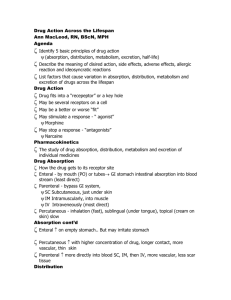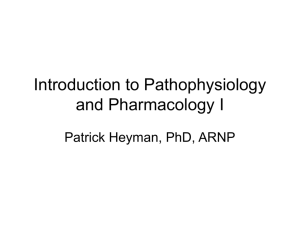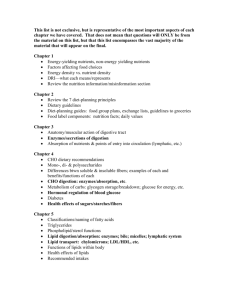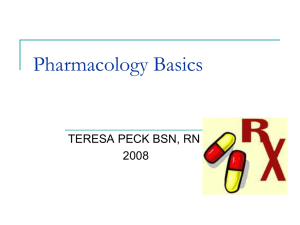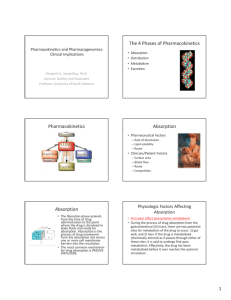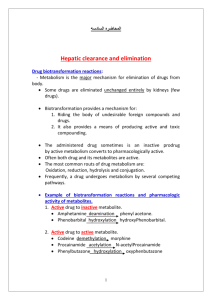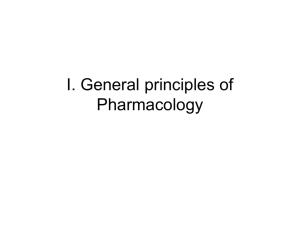Pharmacology 120
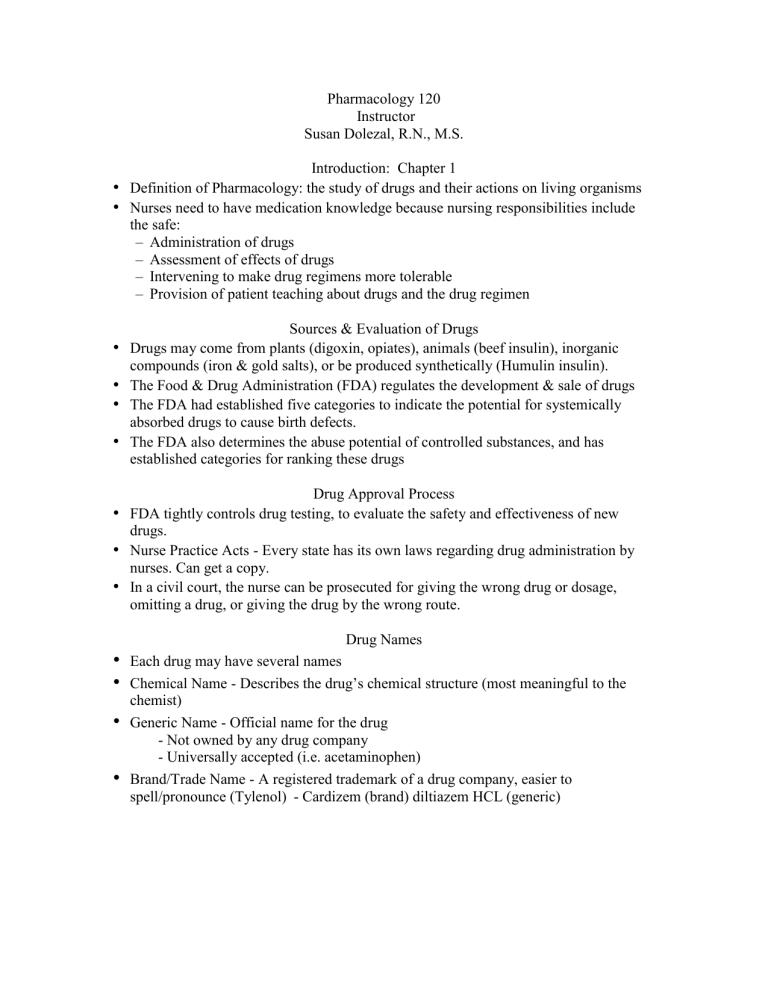
Pharmacology 120
Instructor
Susan Dolezal, R.N., M.S.
Introduction: Chapter 1
•
Definition of Pharmacology: the study of drugs and their actions on living organisms
•
Nurses need to have medication knowledge because nursing responsibilities include the safe:
–
Administration of drugs
–
Assessment of effects of drugs
–
Intervening to make drug regimens more tolerable
–
Provision of patient teaching about drugs and the drug regimen
Sources & Evaluation of Drugs
•
Drugs may come from plants (digoxin, opiates), animals (beef insulin), inorganic compounds (iron & gold salts), or be produced synthetically (Humulin insulin).
•
The Food & Drug Administration (FDA) regulates the development & sale of drugs
•
The FDA had established five categories to indicate the potential for systemically absorbed drugs to cause birth defects.
•
The FDA also determines the abuse potential of controlled substances, and has established categories for ranking these drugs
Drug Approval Process
•
FDA tightly controls drug testing, to evaluate the safety and effectiveness of new drugs.
•
Nurse Practice Acts - Every state has its own laws regarding drug administration by nurses. Can get a copy.
•
In a civil court, the nurse can be prosecuted for giving the wrong drug or dosage, omitting a drug, or giving the drug by the wrong route.
Drug Names
•
Each drug may have several names
•
Chemical Name - Describes the drug’s chemical structure (most meaningful to the chemist)
•
Generic Name - Official name for the drug
- Not owned by any drug company
- Universally accepted (i.e. acetaminophen)
•
Brand/Trade Name - A registered trademark of a drug company, easier to spell/pronounce (Tylenol) - Cardizem (brand) diltiazem HCL (generic)
Drug Approval: Pregnancy
•
FDA developed a classification system related to the effects of drugs on unborn child
(fetus)
•
In drug books and literature, pregnancy category is indicated for most drugs
- A - No risk to fetus based on studies
- B - Little to no risk based on animal studies,
some human studies
- C - Risk indicated based on animal studies. Evaluate risk vs. benefit .
- D - Risk to fetus proved. Risk vs. benefit to mother
- X - Risk proved. Avoid during pregnancy
Controlled Substances Schedule
•
1970 - The Controlled Substance Act passed to remedy drug abuse/dependence.
Included scheduling of controlled drugs into classifications:
- CI - Illegal drugs (highest abuse potential – i.e. Heroin)
- CII - High potential for abuse (physical & psychological)
& dependency (narcotics, amphetamines, barbiturates)
- CIII - Combo drugs (Codeine preparations) High
potential for abuse/dependency
- CIV - Medium potential for abuse/dependence (anti-anxiety meds such as Valium)
- CV - Limited potential for abuse (Codeine cough syrup)
Over-The-Counter (OTC) Meds
•
Over-the-counter (OTC) drugs are products that are available without a prescription for self-treatment of various problems
–
Many patients do not report use of OTC meds, as they do not consider them to be
“real medicines”; health care workers must ask about their use!
–
OTC meds can still be dangerous if not taken correctly (limit on acetaminophen dosing!), can interact with other medications, and can mask signs & symptoms of underlying disease (headaches & HTN)
Where To Get Information!
• Physician’s Drug Reference (PDR)
•
Nursing Drug Handbooks
•
Internet Drug Sites: Drug Formulary at: http://www.intmed.mcw.edu/drug.html
•
Package inserts that come with new meds
•
The hospital pharmacist
• 24 hour Walgreen’s or Osco pharmacist!
•
(Be careful with the review questions/answers in the textbook - they aren’t all correct for Chapter 1!)
Chapter 2: Drugs and the Body
•
Definition of Pharmacology: the study of drugs and their actions on living organisms
•
3 Phases for drug action to occur:
•
1 – Pharmaceutic: how the drug gets into the body
•
2 – Pharmacokinetic: how the body acts on the drug
•
3 – Pharmacodynamic: how the drug affects the body
•
* Please refer to the Terms & Definitions sheet attached to your syllabus!
Pharmacodynamics
Categories of Drug Action
4 categories of drug action: (example!):
•
- replacement (insulin)
•
- stimulation of cellular activities (Type II DM meds)
•
- depression or slowing of cellular activities (SSRIs)
•
- to interfere with the functioning of foreign cells, such as invading microorganisms or neoplasms (chemotherapeutic agents: antibiotics and cancer medications)
Pharmacodynamics
Receptor Theory
•
Most receptors are protein in structure and found on cell membranes
•
Drugs act through receptors either by binding to the receptor to produce a response
(agonist) (i.e. insulin letting glucose into the cell) or by blocking a response
(antagonist) (i.e. SSRIs block removal of serotonin from receptor sites – more serotonin available to cell, less depression)
•
Almost all drugs lack specific and selective effects; those which are specific (such as penicillin) are said to have selective toxicity.
•
These other effects may be desirable or harmful (i.e. cancer chemotherapy kills tumor cells, but also causes hair loss & anemia)
Phase 1:
Pharmaceutic
•
Approximately 80% of drugs are taken by mouth and pharmaceutic (dissolution) is the first phase of drug action. Oral administration is the cheapest & safest way to administer drugs, but stomach acid may interfere – hence the use of binders which are broken down at particular acidity levels, then releasing the active drug.
• In GI tract - drugs need to be in solution to be absorbed
•
Solids (tablets, capsules) must disintegrate into small particles to dissolve into liquid
(dissolution)
•
Liquid drugs are already solutions
Pharmaceutic
•
Disintegration - breakdown of the tablet into smaller particles
•
Dissolution - dissolving of the smaller particles in GI fluid before absorption
•
Rate limiting - time it takes the drug to disintegrate and dissolve to become available for the body to absorb it
Pharmaceutic
•
Drugs dissolve faster in acidic environments
- Older adults/infants have less acid; slower absorption leads to toxicity (WHY?)
•
Enteric coated tablets do not disintegrate until reaching the alkaline environment of the small intestine – (they are designed to do this) - DO NOT CRUSH them!
Phase 2:
Pharmacokinetics
•
The process of drug movement to achieve drug action
•
4 processes: Absorption, Distribution, Metabolism (Biotransformation), and Excretion
(elimination) - ADME
•
The nurse must be alert to any adverse drug effects and to report such findings promptly
•
Critical concentration – the amount of drug needed to cause a therapeutic effect; may use a loading dose to achieve more quickly
Phase 2:
Pharmacokinetics
•
Dynamic Equilibrium of drug concentration is affected by the 4 processes of pharmacokinetics:
–
Absorption – from the site of entry into the body
–
Distribution – to the active site
–
Metabolism (Biotransformation) – in the liver
–
Excretion (elimination) – from the body
Pharmacokinetics: Absorption
•
Passage of drug from its site of administration into the blood/circulating body fluids
•
Rate of absorption depends on the route of administration: Enteral (via GI tract), parenteral (injected), topical (through the skin), inhaled into the lungs, through mucous membranes (sublingual, buccal)
Absorption
•
Some drugs are absorbed into the small intestine via the extensive mucosal villi.
When is absorption compromised?
•
Hydrochloric acid (which we all have in our stomachs!) destroys some drugs – so a much larger oral dose must be given to offset the dosage loss. (Compared to dosage of same med given IV or IM.)
•
Ideally, (for consistent absorption) all oral drugs should be given 1 hour before or 2 hours after meals.
Absorption
•
Bioavailability is a subcategory of absorption – it refers to the percentage of the administered drug dose that reaches the systemic circulation
•
Occurs after absorption and hepatic drug metabolism
•
Oral route is always less than 100% - due to first- pass effect (next slide!)
•
Intravenous route is usually 100%
Absorption
•
First Pass Effect: drugs that are taken orally are usually absorbed from the small intestine directly into the portal venous system; the portal veins deliver these absorbed molecules directly into the liver. In the liver, much of the drug becomes inactive & is excreted. Some drugs, such as aspirin & alcohol, do not undergo metabolism in the liver at all; they are absorbed into the body from the lower end of the stomach.
Pharmacokinetics:
Distribution
•
The ways in which drugs are transported by the circulating body fluids to the sites of action
•
Influenced by blood flow, affinity to the tissue, and protein binding effect
•
Drugs are distributed in the plasma (liquid part of the lymph and blood) and are bound by varying degrees to protein (albumin)
Distribution
•
Portion of drug bound to protein is inactive - not available to receptors; drug must be freed from the protein’s binding site at the tissues.
•
Portion of drug unbound is free, active
- only free drugs can cause a pharmacologic response
- some circulating drugs (anticonvulsants, aminoglycosides) are checked for drug blood levels
Distribution
•
Need to be aware of the condition of your client - liver or kidney disease = low serum albumin level = less protein-binding sites = excess free drug. What happens?
•
Remember - The amount of drug that actually reaches the receptor sites determines the extent of pharmacologic activity
Pharmacokinetics:
Metabolism or Biotransformation
•
Major mechanism of the termination/inactivation of drug action
•
Liver is primary site where drugs are inactivated by liver enzymes, becoming inactive metabolites or water- soluble substances for excretion
•
Liver disease alters drug metabolism = drug toxicity d/t a decreased rate of metabolism
•
Drug removal from the body
•
Main route is through the urine
Pharmacokinetics:
Excretion
- other routes = bile, feces, lungs, breast
milk, skin, saliva
•
Urine pH influences excretion
•
Kidney disease affects excretion (like liver disease, leads to build up of drug and toxicity)
•
Half-life (t1/2) - the time it takes for 1/2 of a drug to be eliminated; after 5 half-lives,
>96% of drug is eliminated.
Phase 3:
Pharmacodynamics
•
Def: How the drug affects the body
•
Drug response can cause a primary or secondary physiologic effect, or both
•
Primary effect = desirable
•
Secondary effect = desirable or undesirable (i.e. Benedryl –antihistamine >sleepy)
Pharmacodynamics
Onset, Peak, Duration
•
Onset of action = time it takes to reach the minimum effective concentration
•
Peak action = When the drug reaches its highest blood or plasma concentration
•
Duration of action = Length of time drug has an effect (this is where knowing the t ½ and the condition of the patient’s liver & kidneys comes in handy!)
Pharmacodynamics
Therapeutic Index/Range
•
Safety of drugs is a major concern
•
Therapeutic index - estimates the margin of safety of a drug
•
Low therapeutic index = narrow safety
•
High therapeutic index = wide safety margin, less danger of toxic effects
•
Therapeutic range = area between the minimum effective concentration & minimum toxic concentration of a drug
Pharmacodynamics:
Factors Influencing Drug Effects
•
Info in drug books is based on the reaction (to the drug) on a healthy, 150 # male!
•
Weight: if < 150 #, normal dosage might prove toxic; if > 150#, normal dose might not cause desired response
•
Age: children need to have dosages converted appropriately. Older adults usually need lower doses as well, due to decreased plasma proteins, & decreased liver & kidney function.
Factors Influencing Drug Effects (cont.)
• Gender: males have more vascular muscles; so IM injections act more quickly in men than women; women have more fat cells; so drugs deposited in fat (like gas anesthetics) act much longer in women.
•
Physiological factors: diurnal rhythm of the nervous & endocrine systems, acid-base balance, & electrolyte balance all affect the way the drug works in each individual
•
Pathological factors: i.e. GI disorders can affect the absorption of many oral drugs; vascular diseases & low B/P affect the distribution of drugs: not enough “umph” to get drug to tissues where it is needed. Liver & kidney disease:
Factors Influencing Drug Effects (cont.)
•
Genetic factors: cultural differences due to differences in enzyme levels
•
Immunological factors: drug allergies
•
Psychological factors: placebo effect: drug works best when patient believes it will work. Health beliefs (trust), & compliance with treatment
•
Environmental factors: heat & vasodilators for hypertension, sedating drugs & calm, quiet environment
Factors Influencing Drug Effects (cont.)
•
Tolerance: patient may develop tolerance to drugs over time, requiring larger dose to achieve initial effect.
•
Cumulation: if drug doses taken too close together, drug accumulates in the body, leading to “overdosage” and toxic effects
•
Drug-drug interactions: when two or more drugs are taken together, they can increase of decrease the efficacy of one or both drugs. Can occur during all phases (ADME).
Check drug handbook.
•
Drug-food interactions: i.e. tetracycline & milk
•
Drug-laboratory interactions: i.e. change in liver enzymes
